
Silk Road Trade & Travel Encyclopedia
丝绸之路网站(丝路网站)
丝绸之路百科全书—游客、学生和教师的参考资源
İPEK YOLU ve YOLLARI ANSİKLOPEDİSİ
www.ipekyollari.net

Silk Road Trade & Travel Encyclopedia
丝绸之路网站(丝路网站)
丝绸之路百科全书—游客、学生和教师的参考资源
İPEK YOLU
ve YOLLARI
ANSİKLOPEDİSİ
www.ipekyollari.net
S
A B
C
D
E
F
G
H I
J
K
L
M
N O P
Q
R
S
T
U V
W
X
Y
Z
Saddle A saddle is a supportive structure for a rider or other load, fastened to an animal's back by a girth. The most common type is the equestrian saddle designed for a horse, but specialized saddles have been created for camels. Eurasian nomads, known in Europe as Scythians, and in Asia as Saka, developed an early form of saddle. More...
Saharan Trade Routes (or Trans-Saharan) is trade across the Sahara desert between Mediterranean countries and sub-Saharan Africa. While existing from prehistoric times, the peak of trade extended from the 8th century until the late 16th century, and included trade between Europe and Africa. Before the Phoenicians took control of vast areas, three ancient routes connected to the Mediterranean coast of Africa (the herdsmen of the Fezzan of Libya, known as the Garamantes, controlled these routes as early as 1500 BC). From the 5th century BCE to the 5th century of the modern era, the Fezzan was home to the Garamantian Empire, a city state which operated the Trans-Saharan trade routes between the Carthaginians -- and later the Roman Empire -- and Sahelian states of west and central Africa. (See also Carthage) More...
Sailimu Lake is located in the Bortala Mongolian Autonomous Prefecture in the Xinjiang Uygur Autonomous Region of China.
Sajo (Battle of Mohi, Muhi) was the main battle between the Mongol Empire and the Kingdom of Hungary during the Mongol invasion of Europe. It took place at Muhi, southwest of the Sajó River. More...
Sakas Saka nomads from Central Asia migrated to the northwestern Indian subcontinent in the first and second centuries BCE. Herodotus describes the extent, customs, and origins of various groups of Scythians (designation for Sakas in Greek-Western classical sources) who inhabited large areas of the steppes of Central Asia on the northern peripheries of the Greek world. The Sakas are also known from Old Persian inscriptions of the Achaemenid Empire. The Naqs-i-Rustam inscription of Darius I distinguishes three groups of Sakas. Chinese historical annals refer to the movements of the Sai (Chinese designation for Sakas) southwards into northwestern India following a period of disturbances in Central Asia during the second century BCE. According to the History of the Former Han (Han shu), covering the period from 206 BCE to 25 CE: "When the Hsiung-nu [Xiongnu] conquered the Yueh-chih [Yuezhi], the latter moved west, and established themselves as masters of Ta Hsia [Da xia]..." Sakas were in control of major commercial centers along the "Northern Route" (Uttarapatha) and "Southern Route" (Dakshinapatha) trade routes, and encouraged the development of trade networks.
Samanids (874-999) for 180 years established a Persian state and empire in Central Asia and Greater Khorasan. In 999, the Karakhanid leader Sultan Satuq Bughra Khan, grandson of the tribal chief of the Karluk confederation, occupied Bukhara, the Samanid capital. The Samanid domains were split up between the Ghaznavids, who gained Khorasan and Afghanistan, and the Karakhanids who received Transoxania; the Oxus River thus became the boundary between the two rival empires. During this period the Karakhanids converted to Islam. More...
Samarkand (Samarqand, also known as Maracanda) City near Bukhara in modern-day Uzbekistan, which was taken intact by the Mongols in 1220. For 2,500 years the great Sogdian capital of Samarkand was the wealthiest city on the Central Asian Silk Road, ushering bales of Chinese silk through to Byzantium. In A.D. 751, an Arab victory at the battle of nearby Talas is said to have led to the capture of Chinese artisans who were forced to divulge the secret of papermaking (a subject still debated by scholars). During the 14th century, the Timurids conquered Asia from Egypt and Syria to the borders of China, making Samarkand their capital.
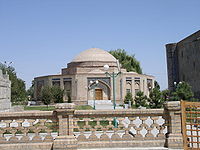
The ancient trading dome "Chorsu" confirms that Registan was medieval Samarkand's commercial center which included a market.
The city was the capital of Sogdiana, an ancient Persian province, and was conquered by Alexander the Great in 329 BC. It subsequently grew as a trade center on the route between China and the Mediterranean region. In the early 8th century AD, it was conquered by the Arabs and soon became an important center of Muslim culture. In 1220 Samarkand was almost completely destroyed by the Mongol invasion. It flourished again when Timur made it the capital of the Tumurid Empire in 1369. As his capital, Timur put Samarkand on the world map, and much of the architecture visible today was built by him or his descendants.
Sanwei Mountain is near the Mogao Caves in Gansu China. The Guanyin Buddhist Temple Pavilions and murals are located here.
Sarmatians were an Iranian people of Classical Antiquity, flourishing from about the 5th century BC to the 4th century AD. Their territory was based in the western part of greater Scythia (modern Southern Russia, Ukraine, and the eastern Balkans). At their greatest reported extent, around 100 BC, these tribes ranged from the Vistula River to the mouth of the Danube, and eastward to the Volga, bordering the shores of the Black Sea, and Caspian Sea, as well as the Caucasus to the south. More...
Sassanid Empire (also spelled Sasanid Empire, Sassanian Empire, or Sasanian Empire) was the last pre-Islamic Persian Empire, ruled by the Sasanian Dynasty from 224 to 651. The Sassanid Empire, which succeeded the Parthian Empire, was recognized as one of the two main powers in Western Asia and Europe, alongside the Roman Empire and later the Byzantine Empire, for a period of more than 400 years.
Scroll A scroll is a roll of papyrus, parchment, or paper which has been written, drawn or painted upon for the purpose of transmitting information, or using as a decoration. The practice of writing with ink and a sharp-pointed needle was common practice since antiquity in South India. Many sources maintain that the Chinese invented and perfected 'Indian Ink' for use in writing, including on scrolls (See Chinese philosopher, Tien-Lcheu, 2697 B.C.). Indian documents written in Kharosthi with this ink have been unearthed as far as Xinjiang, China. More...
Scythians (Scyths) were an ancient Iranian people of horse-riding nomadic pastoralists who throughout Classical Antiquity dominated the Caspian steppe, known at the time as Scythia. The Scythian Empire of the Western Steppe in Eurasia lasted from the 8th century BC to the 2nd century AD. (See Sakas) More...
Secret History of the Mongols The most important early Mongolian chronicle, which describes the origins of the Mongols and the history of the rise to power of the Mongol Empire. The text exists in two versions. One surviving copy of the work comprises transcriptions of the original Mongolian text with Chinese characters, and the other copy is in the Mongolian script written in the 16th century. The Secret History of the Mongols is the oldest surviving Mongolian-language literary work. It was written for the Mongol royal family some time after Genghis Khan's death in AD 1227, by an anonymous author and probably originally in the Uyghur script, though the surviving texts all derive from transcriptions into Chinese characters dating from the end of the 14th century. The Secret History is regarded as the single significant native Mongolian account of Genghis Khan. Linguistically, it provides the richest source of pre-classical Mongolian and Middle Mongolian. The Secret History is regarded as a piece of classic literature in both Mongolia and the rest of the world.
Seismoscope The Chinese philosopher Chang Hęng c.132 A.D invented the earliest known seismoscope (instrument that indicates the occurrence of an earthquake).
Selcuk Turks (a.k.a. Seljuks; in Turkish Selçuklular; in Persian: سلجوقيان ; in Arabic سلجوق ) were a Turkic dynasty that ruled parts of Central Asia and the Middle East from the 11th to 14th centuries. The Selcuk's established an empire, the "Great Seljuq Empire," which at its height stretched from Anatolia in Turkey and through Persia. The empire was the target of the First Crusade. The Selcuk Dynasty had its origins in the Turcoman tribal confederations of Central Asia, and marked the beginning of Turkic power in the Middle East.
Prior to the ninth century, Turkic groups had crossed the Volga River into the Black Sea steppes. Originally, the House of Seljuq was a branch of the Qinik (Kınık) Oghuz Turks, who in the 9th century lived on the periphery of the Muslim world, north of the Caspian and Aral seas in the Yabghu Khaganate of the Oghuz confederacy in the Kazakh Steppe of Turkestan. In the 10th century the Selcuks migrated from their ancestral homelands into mainland Persia, to the province of Khurasan, where over the decades they mixed with the local population and used the Persian culture and language. More...
Sericulture is the rearing of silkworms for the production of raw silk. According to Confucian texts, the discovery of silk production dates to about 2700 BC, although archaeological records point to silk cultivation as early as the Yangshao period (5000 – 10,000 BC). Around the first half of the 1st century AD, silk cultivation had reached ancient Khotan, and by AD 300 the practice had been established in India. Later it was introduced to Europe, the Mediterranean and other Asiatic countries. Today, China, India, Uzbekistan, Brazil and Iran are the main producers of silk (with China and India manufacturing more than 60% of world production per year). More...
Shaan (See Xi'an, Chang'an) Located in Shaanxi province (also called Qin, presumably after Emperor Qin, who united China in 221 BC and made his capital in Shaan). "China" can be said to have began in Xi'an Shaanxi province when the first Emperor Qin (from whom China gets its name) finished conquering and united the warring states. The entombed Terracotta Army stands as a monument to the power of Emperor Qin.
Shaanxi (See Xi'an, Chang'an) province in northwestern China is considered one of the cradles of Chinese civilization and the starting point of the Silk Road. The province's principal city and current capital, Xi'an, is one of the four great ancient capitals of China and is the eastern terminus of the Silk Road, which led to Central Asia, Europe, Arabia and Africa. Also called Qin, presumably after the first Qin Emperor who united China in 221 BC and made his capital in Xi’an, it is here that the entombed Terracotta Army stands as a monument to the power of Emperor Qin. Shaanxi also is home to numerous sites on UNESCO's World Heritage List.
Many dynasties established their capitals in the province during a span of more than 1,100 years. Under the Han Dynasty, the Northern Silk Road was expanded to advance exploration and military needs to the west. This Northern Silk Road is the northernmost route of the "Silk Routes" and is about 2,600 kilometers in length. It connected the ancient Chinese capital of Xi'an to the west over the Wushao Ling Pass to Wuwei, and passed through Kashgar before linking to ancient Parthia. Under the Ming dynasty, Shaanxi was incorporated into Gansu but was again separated in the Qing dynasty. More...

Famen Temple is famous for housing four important Buddhist relics linked to
Siddhartha Guatama, the founder of Buddhism.
The temple was originally built during the East Han Dynasty (206 BC – 220AD),
but was rebuilt.
Shahrud is an Iranian Silk Road city. One of the largest Caravanserais in Iran is located 105 kilometers east of the city of Shahrud.
Shahrukh (Shah Rukh) Timurid ruler who sent a large-scale mission to Beijing in 1419 (including the artisit Ghiyathuddin Naqqash).
Shamanism is based on the premise that the visible world is pervaded by invisible forces or spirits which affect the lives of the living. Shamanism is an anthropological term referencing a range of beliefs and practices regarding communication with the spiritual world. In Europe, Shamanism had a strong tradition before the rise of monotheism, Today, shamanism survives primarily among indigenous peoples throughout the world. Chinese shamanism has the longest recorded history in the world. In Eurasia it was practiced by grassland nomads of the Steppes, and played an important role in Altaic mythology. Tengriism which was the major belief of Xiongnu, Turkic, Hungarian and Bulgar peoples in ancient times incorporates elements of shamanism. More...
Shanshan is the Chinese name for a kingdom that existed roughly from 200 BCE-1000 CE at the north-eastern end of the Taklamakan Desert including the great, but now mostly dry, salt lake known as Lop Nur. (See Loulan) More...
Shazhou is the ancient name of Dunhuang, which lies at the western end of the Hexi Corridor. The region is famous for many sites of interest including the Mogao Grottoes, Singing-Sand Dunes, Crescent-Moon Spring, Yang Pass and Yumen Pass. Dunhuang Movie Set, also known as the "Modeled Shazhou Town" of the Song Dynasty is southwest of Dunhuang City. The town, covering an area of 12,700 square meters was originally designed for the setting of the historical film Dunhuang in 1987. The town presents its majestic appearance in the vast Gobi, bearing the richness of the west regions of China. Fully representing the military importance of the western regions in the Tang (618-907) and Song Dynasties (960-1279), the complex gives the impression that the clock has turned backwards to ancient times. (See Dunhuang)
Shihezi is a city located in the Gobi Desert in the Xinjiang Uygur Autonomous Region of China.
Silk For centuries silk has been sought after by many peoples and countries. Silk is produced by the fibrous secretion of silkworms used to make thread and fabric. The silk trade began even before recorded travel took place on the Silk Road. The discovery of an Egyptian mummy with silk (in the village of Deir el Medina near Thebes and the Valley of the Kings) serves as evidence that the silk trade from east to west can be dated to about 1070 BC, although the Silk Road was known to be open during the days of the Han and Roman empires (the Chinese emperor Han Wu is credited for sending envoys to Persia and Mesopotamia during the second century BC for diplomatic purposes, with gifts that included silk).
Historical records suggest that sericulture developed as early as c. 4000-3000 BCE. It is certain that by the second century BC, silk-making had spread throughout southern China. For more than a thousand years, silk was so valuable that it was often used as currency. The process of making it was also a jealously guarded secret which the Chinese managed to keep until the fifth century. Although the Emperors of China strove to keep knowledge of sericulture a secret to maintain the Chinese monopoly, mass production of silk today has reached over 30 countries. However, the major center of production is still China. More...
Woven silk textile from tomb no 1. at
Mawangdui
in Changsha,
Hunan province,
China,
from the
Western Han Dynasty, 2nd century BC
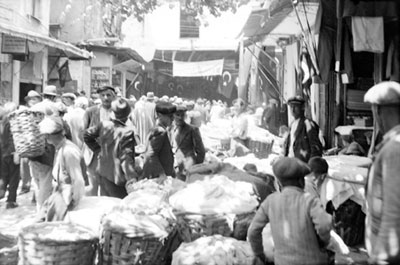
The silk carpets of
Hereke,
recognized as the finest hand knotted carpets in the world,
are made
with silk from Bursa, Turkey.
Silk Industry/Production The silk industry began in China sometime before the middle of the 3rd millennium BCE, according to historic Chinese records. It became an important feature of the Chinese rural economy. Silk weaving became a major industry and one of China's chief exports in the Han dynasty. The caravan route across Central Asia, known as the Silk Road, took Chinese silk to Syria, and on to Rome. According to legend, about 140 BCE, sericulture as well as silk had spread overland from China to India. By the 2nd century CE India was shipping its own raw silk and silk cloth to Persia (a few centuries later, Japan, also developed in sericulture). Persia became a centre of silk trade between East and West under the Parthians (247 BCE–224 CE). Silk dyeing and weaving developed as crafts in Syria, Egypt, Greece, and Rome. Although some raw silk from East Asia was used, most yarn was derived by unraveling silk fabrics from the East -- and Silk culture remained a secret of Asia. Eventually a strong demand for the local production of raw silk arose in the Mediterranean area. It is said that Byzantine Emperor Justinian I (from 527 to 565) persuaded two Persian monks who had lived in China to return there and smuggle silkworms to Constantinople (now Istanbul) in the hollows of their bamboo canes (c. 550 CE). Thus, many believe that these silkworms were the beginning of all the varieties that stocked and supplied European sericulture until the 19th century. Silk culture flourished in Europe for many centuries, especially in the Italian city-states, and from 1480 in France. Silk continues to be an important luxury item of trade.
Silk Road (See Silk Routes) Centuries-old interconnected networks of trade routes across Eurasia which linked the Asian and Mediterranean worlds since antiquity.
Silk Road (Silk Routes) Chinese Section of the Silk Road
The Chinese Section of the Silk Road began in the city of Xi'an in Shaanxi Province, passed through the provinces of Gansu, Ningxia, Qinghai and continued westward through Xinjiang into Central Asia. More than half of the Silk Road (which stretched between Xi'an in China to the Mediterranean Sea and Turkey) was located in China.

The Chinese Section of
the Silk Road began in the city of Xi'an in Shaanxi Province,
passed through the provinces of Gansu, Ningxia, Qinghai and continued westward
through Xinjiang into Central Asia.
More than half of the Silk Road--which stretched between Xi'an in China to the
Mediterranean Sea and Turkey--was located in China.
The Xinjiang region is strategically located at the junction where the most ancient branch of the famous “Silk Route” joining China and the West meets with one of the main routes from ancient India and Tibet, crossing from Central Asia to other areas of China. Xinjiang was the crossroads for not only goods, but also was home to the northern and southern routes which enabled technologies, philosophies, and religions to be transmitted from one culture to another.
Silk Routes (or the Silk Road, İpek Yolu) can be briefly described as a network of ancient overland trade routes that extended across the Asian continent and connected China to the Mediterranean Sea. (See Homwork Help / Definition)
The "Silk Routes" are collectively known as the "Silk Road." For almost 3,000 years, the Silk Routes were important paths for commercial, cultural, and technological exchange between traders, merchants, pilgrims, missionaries, soldiers, rulers, nomads and urban dwellers from Ancient China, India, Persia, Asia Minor, and countries of the Mediterranean.
Extending over 6,000 miles, the routes enabled people to transport goods, especially
luxuries such as silk, slaves, satin and other fine fabrics, musk, perfumes, spices, medicines, jewels, glassware and
porcelain. The routes served as a conduit for the spread of knowledge, ideas,
religions, cultures, and disease
between different parts of the world (along with maritime routes from China, India, Asia Minor,
Europe, Arabia, North Africa, and the Mediterranean). Trade on the Silk Road was a significant factor in the
development of the great civilizations of China, India, Egypt, Persia, Arabia
and Rome, and in several respects helped lay the foundations for the modern
world. Although the term the Silk Road implies a continuous journey, very few
who traveled the route traversed it from end to end. For the most part, goods
were transported by a series of agents on varying routes, and were traded in the
bustling mercantile markets of the oasis towns.
During the Han Dynasty (206BC—220AD) the central Asian sections of the trade routes were expanded,
largely through the missions and explorations of Zhang Qian who traveled
upon the Silk Routes between 138 BC to 139 BC. In the late
Middle Ages, transcontinental trade over the land routes of the Silk Road
declined as sea routes increased and maritime trade developed. Though silk was certainly
a valued trade item
from China, many other products were traded, and various inventions, religions
and philosophies traveled along the Silk Routes.
(Click for Silk, Spice & Incense Routes)
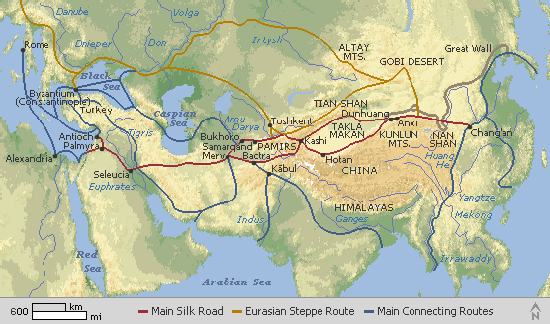
Overland Silk Routes
As it extends westwards from the ancient commercial centers of China, the
overland, intercontinental Silk Road divides into the northern and southern
routes bypassing the Taklamakan Desert and Lop Nur.
The northern route began in China at Chang'an (modern-day Xi'an).
The route travels northwest through the Chinese province of Gansu from Shaanxi
Province, and splits into three further routes, two of them following the
mountain ranges to the north and south of the Taklimakan Desert to rejoin at
Kashgar; and the other going north of the Tian Shan mountains through Turpan,
Talgar and Almaty (in what is now southeast Kazakhstan). The routes split west
of Kashgar with one branch heading down the Alai Valley towards Termez and
Balkh, while the other traveled through Kokand in the Fergana Valley, and then
west across the Karakum Desert towards Merv, joining the southern route briefly.
One of the branch routes turned northwest to the north of the Aral and Caspian
seas and on to the Black Sea. Yet another route started at Xi'an, passed
through the Western corridor beyond the Yellow Rivers, Xinjiang, Fergana (in
present-day eastern Uzbekistan), Persia and Iraq before joining the western
boundary of the Roman Empire. It has been recorded that the northern Silk Road
caravan route brought to China many goods such as "dates, saffron powder and
pistachio nuts from Persia; frankincense, aloes and myrrh from Somalia;
sandalwood from India; glass bottles from Egypt, and other expensive and
desirable goods from other parts of the world."
The southern route is mainly a single route running from China, through
Karakoram. Today there exists an international highway connecting Pakistan
and China, known as "Korakoram Highway." The route then continues to the Turkestan–Khorasan
region, Mesopotamia, and into Anatolia, with southward routes enabling the
journey to be completed by sea from various points.
The branch which crosses the high mountains, then
passes through northern Pakistan, over the Hindu Kush mountains, and into
Afghanistan, rejoins the northern
route briefly near Merv. From there it follows a nearly straight line west
through mountainous northern Iran and the northern tip of the Syrian Desert to
the Levant, where Mediterranean trading ships plied regular routes to Italy, and
land routes went either north through Anatolia or south to North Africa. Another
branch road traveled from Herat through Susa to Charax Spasinu at the head of
the Persian Gulf and across to Petra and on to Alexandria and other eastern
Mediterranean ports from where ships carried the cargoes to Rome.
Maritime Silk Routes
As much as 1,400 years ago, during China's Eastern Han Dynasty, a sea route,
although not part of the formal Silk Route, led from the mouth of the Red River
near modern Hanoi, through the Malacca Straits to Southeast Asia, Sri Lanka and
India, and then on to the Persian Gulf and the Red Sea kingdom of Axum, and
eventually to Roman ports. From ports on the Red Sea, goods including silks, were
transported overland to the Nile and then to Alexandria from where they were
shipped to Rome, Constantinople and other Mediterranean ports.
Another branch of these sea routes led down the East African coast, called
"Azania" by the Greeks and Romans in the 1st century CE, as described in the
Periplus of the Erythraean Sea (and perhaps 澤散 Zesan in the 3rd century
by the Chinese), at least as far as the port known to the Romans as "Rhapta,"
which was probably located in the delta of the Rufiji River in modern Tanzania
(commonly referred to as Zanzibar).
Cities such as Istanbul, Venice, and Guangzhou were key transportation hubs and trading ports which could be considered maritime cities of the Silk Road. Thus, European and Asian ports were indirectly connected to caravan routes of the Silk Road.
Maritime trade between East and West developed across the Indian Ocean between Alexandria in Egypt and Guangzhou in China. From Guangzhou, the Silk Road extends from China, to present day Brunei, Myanmar (Burma) Thailand, Malacca, Ceylon, India, Pakistan, the Philippines, Iran and Iraq. In Europe it extends from Israel, Lebanon (collectively, the Levant), Egypt, and Italy (Venice) in the Mediterranean Sea to other European ports or caravan routes such as the great Hanseatic League Fairs via the Spanish road and other Alpine routes. This water route has been called by some sources as the Indian Ocean Maritime System. (See also Roman-India routes) More...
Silk Route Museum The "Silk Route Museum" is located in Jiuquan, Gansu Province, and is built over the tomb of the Xiliang King. The museum's extensive exhibits include rare antique ceramics, jades, bronze wares, and artifacts that originated from the rich historic past of the Silk Route. The museum is committed to promoting understanding between East and West by focusing on the study of the extraordinary range of cultures along the Silk Road. More...
Silk Worms The silkworm is the larva or caterpillar of the domesticated silkmoth, Bombyx mori (Latin: "silkworm of the mulberry tree"). It is an important economic insect since it is the producer of silk. Silkworms were first domesticated during the Han Dynasty in China about 2000 years ago. More...
Sina (Abu Ali Ibn Sina) (See Avicenna)
Sinbad the Sailor (See Suhar)
Sincan (Sincan Uygur - See Xinjiang)
Sinology (Chinese Studies) The study of Chinese language, literature, or civilization. A person who studies in this field is called a sinologist. More...
Slaves The ancient routes enabled people not only to transport goods and products, but also slaves who were traded and sold throughout the world in different markets.
Sogdiana (Balasagun) dominated the trade along the Silk Route from the 2nd century BC until the 10th century AD. Sogdians played a major role in facilitating trade between China and Central Asia along the Silk Routes. Sogdian contacts with China were triggered by the embassy of the Chinese explorer Zhang Qian during the reign of Wudi in the former Han Dynasty, 141-87 BC. He wrote a report of his visit to the "Western Regions" in Central Asia, and named an area of Sogdiana, "Kangju."
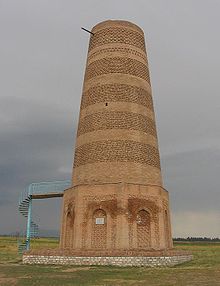
Tower in city of Burana
Sogdiana played an important role in the religious and cultural development of central Asia. Muslim geographers of the 10th century used Sogdian records dating to 750-840. After the end of the Uighur Empire (8th - 9th centuries), Sogdian trade underwent a period of unstable condictions. The Samanids of Muslim Central Asia resumed trade on the northwestern road leading to the Khazars and the Urals, and the northeastern road toward nearby Turkic tribes. Turpan under Tang Dynasty rule was a center of major commercial activity between Chinese and Sogdian merchants, and hosted many caravanserais. More...
Southern Route (See Silk Road) wandered west along the northern foot of the Kunlun Mountains, passing Ruoqiang (Charkhlik), Qiemo (Cherchen), Hetian, Yecheng (Karghalik), Shache (Yarkand) and reached Kashgar (the last point of the Silk Road in China). The route then crossed the snow-covered Pamirs, reaching Pakistan and India via Kashmir (however, it could also reach Europe through Islamabad, Kabul, Mashhad, Baghdad and Damascus).
The southern route is mainly a single route running from China, through Karakoram. Here it is nowadays the international paved road connecting Pakistan and China as the Karakoram Highway. It then continues to Turkestan–Khorasan region, Mesopotamia, and into Anatolia, with southward spurs enabling the journey to be completed by sea from various points. It starts out southwards in China. Crossing the high mountains, then it passes through northern Pakistan, over the Hindu Kush mountains, and into Afghanistan, rejoining the northern route briefly near Merv. From there it follows a nearly straight line west through mountainous northern Iran and the northern tip of the Syrian Desert to the Levant, where Mediterranean trading ships plied regular routes to Italy, and land routes went either north through Anatolia or south to North Africa. Another branch road traveled from Herat through Susa to Charax Spasinu at the head of the Persian Gulf and across to Petra and on to Alexandria and other eastern Mediterranean ports from where ships carried the cargoes to Rome.
Spice Bazaar (Market) (Turkish: 'Mısır Çarşısı,' or Egyptian Spice Bazaar) Many spices were were bought and sold via Egypt during the Ottoman Empire. One of the world's most famous spice markets is located in Istanbul, Turkey. "The Spice Bazaar," built in 1664, is part of one of the oldest bazaar complexes. It is the second largest covered shopping complex after the the city's famous "Grand Bazaar." More...




Spice Islands most commonly refers to the Moluccas (Maluku) Islands in Indonesia, once the only source of mace and nutmeg. The islands, situated along important sea routes, were active in the lucrative spice trade which led to the Spice Wars between the European maritime powers after the 16th century. (The islands should not be confused with Grenada, which is commonly known as the Island of Spice. The term Spice Islands has also been used to refer to other islands known for their spice production, notably the Zanzibar Archipelago off East Africa. A number of these islands were formerly part of Zanzibar, but now form a semi-autonomous part of Tanzania). More...
Spice Routes As trade between India and the Greco-Roman world increased spices became the main import from India to the Western world, rivaling silk and other commodities. The Indian commercial connection with South East Asia proved vital to the merchants of Arabia and Persia during the 7th century and the 8th century. The Abbasids used Alexandria, Damietta, Aden and Siraf as entry ports to India and China. Merchants arriving from India in the port city of Aden paid tribute in form of musk, camphor, ambergris, and sandalwood to Ibn Ziyad, the sultan of Yemen. Moluccan products shipped across the ports of Arabia to the Near East passed through the ports of India and Sri Lanka. Indian exports of spices are mentioned in the works of Ibn Khurdadhbeh (850), al-Ghafiqi (1150 AD), Ishak bin Imaran (907) and Al Kalkashandi (14th century). After reaching either the Indian or the Sri Lankan ports, spices were sometimes shipped to East Africa, where they were used for many purposes, including burial rites. On the orders of Manuel I of Portugal, four vessels under the command of navigator Vasco da Gama rounded the Cape of Good Hope, continuing to the eastern coast of Africa to Malindi to sail across the Indian Ocean to Calicut. The wealth of the Indies was now open for the Europeans to explore; the Portuguese Empire was one of the early European empires to grow from the spice trade. More...
Spice Trade The spice trade was a commercial activity of ancient origin. Civilizations of Eurasia were involved in the spice trade since ancient times (see also Greco-Roman world and Incense Route of Roman-India Trade). Over the centuries many centers of trade flourished, including the maritime trading nation of Axum in northeastern Africa, the Levant, the Republic of Venice, and the Ottoman Empire. Although the spice trade was dependent on overland ancient routes, maritime trade routes led to the rise of commercial activities. During the medieval periods Muslim traders dominated maritime spice trading routes throughout the Indian Ocean, linking regions in the Far East, and shipping spices from trading centers in India westward to the Persian Gulf and the Red Sea, from which overland routes led to Europe. Trade was transformed by the European Age of Discovery. The route from Europe to the Indian Ocean via the Cape of Good Hope was pioneered by the Portuguese explorer navigator Vasco Da Gama in 1498, resulting in new maritime routes for trade, which eventually ushered in an age of European domination in the East, as well as increased cultural and commercial exchanges between diverse cultures, while nations struggled to gain control of the trade along the many routes. More...
Spice Wars (See Moluccas Islands)
Steppes Open pasture lands. The vast grassland steppes of Asia enabled merchants to travel immense distances. More...
Steele
Richard Steele and John Crowther (1615-1616) Agents for the British East India
Company, traveled from Agra, the Mughal capital in N. India, overland via
Kandahar to the Safavid capital Isfahan. Their account highlights the continuing
importance of the overland trade routes, in part as a way of avoiding the
Portuguese control of the Indian Ocean ports. There is interesting information
on the role of the Afghan nomads along the route and an emphasis on the relative
safety of travel in the period of Mughal and Safavid stability and rule.
Steele returned to England by traveling overland to the Mediterranean and taking
a boat via Marseilles. Crowther returned to India.
Stein
Sir Aurel Stein was a Hungarian archaeologist
active during British explorations of Central Asia, which started in the wake of
the 19th-century Great Game, when Britain and Russia had vied for political
control. He is primarily known for his explorations and archaeological
discoveries in Central Asia. He was also a professor at various Indian
universities. The artifacts he collected are divided between the British
Museum, the British
Library, the Srinagar
Museum, and the National
Museum in New Delhi. See IDP
More...
Stirrup A stirrup is a light frame or ring that holds the foot of a rider, attached to the saddle by a strap, often called a stirrup leather. Stirrups are usually paired and are used to aid in mounting and as a support while using a riding animal (usually a horse, or mule). They greatly increase the rider's ability to stay in the saddle and control the mount, increasing the animal's usefulness to humans in areas such as communication, transportation and warfare. In antiquity, the earliest foot supports consisted of riders placing their feet under a girth or using a simple toe loop. Later, a single stirrup was used as a mounting aid, and paired stirrups appeared after the invention of the treed saddle. The use of paired stirrups is credited to the Chinese Jin Dynasty and came to Europe during the Middle Ages. Some argue that the stirrup was one of the basic tools used to create and spread modern civilization, possibly as important as the wheel or printing press. More...
Stone City is located near Kashgar, north of Tashkurgan County, in Xinjiang Province of China. The area for centuries has been well-known for its strategic location, situated at the junction of the middle route and southern route of the ancient Silk Road. This is also where routes from Kashgar, Shache, Yingjisha and Yecheng (on way to the Pamirs) meet.
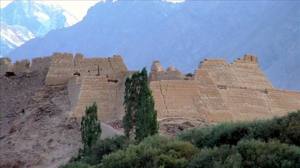
Stone Stele Forest (Forest of Stone Tablets Museum) Inside the city of Xi'an, the starting point of the Silk Road in China, this museum houses the largest collection of stone tablets in China. The oldest steles date back to the Song Dynasty. Over the years many more were added, now totaling 2,300.The museum mainly consists of works of literature and philosophy, historical records, calligraphy and pictorial stones. The museum was originally built in the Northern Song dynasty (1090 AD) when a large Confucian collection of steles cut in A.D. 837, known as the oldest existing texts of the Confucian classics, were moved here for safekeeping.
Stupa A structure built as an object of worship, often containing a relic of the Buddha or another Buddhist figure. The design of stupas varies through the different cultures in which Buddhism has been present. The circumambulation of stupas is a popular way of accumulating merit (the state of suffering, "duhkha," which according to the Buddha is experienced by sentient beings in an endless cycle of birth, death and rebirth).
Sufism is considered by it adherents as the inner, mystical dimension of Islam. A person who believes in this tradition is generally known as a Sufi, or Dervish. Sufi travelers to Central Asia, after the Arab invasions of the 7th and 8th centuries, played an important role in the spread of Islam eastwards and along the Silk Routes. Sufi mysticism has long exercised a fascination upon the Western world, and especially upon Orientalist scholars. The writings of Sufi figures such as Rumi (born c.1207 Afghanistan, died 1273 Turkey), or Yunus Emre (c.1240-1321) have become popular in the West. Sufi poets such as Ibn-Arabi, and Attar have also been a subject of study and interest. More...
Sugong Pagoda or Emin Minaret. (See Turpan)
Suhar (Majan) a port town to the north of Muscat, is the legendary home of Sinbad the Sailor. Suhar was a center of Sassanian maritime activity since the 3rd century, but reached its peak in the Muslim era when, according to Arab historian al-Maqadisi, it was "the hallway to China, the store house of the East and Iraq, and the mainstay of Yemen."
Sultan Suleyman (also known as "Suleyman the Law Maker" or "Suleyman the Magnificent," Soliman, Suleiman) Suleyman became an Ottoman sultan in 1520 (died at Szigetvár, Hungary) and presided over the apex of the Ottoman Empire's military, political and economic power. Suleyman personally led Ottoman armies to conquer regions of Europe before his conquests were checked at the Siege of Vienna in Austria in 1529. He took control of most of the Middle East and large areas of North Africa, as far west as Algeria. Under his rule, the Ottoman fleet dominated the seas from the Mediterranean to the Red Sea and Persian Gulf. It was after the 1500's, with the rise of maritime routes and European expansion, that Silk Road trade declined. More...
Sultaniye (Sultaniyya, Soltaniyeh, or Sultaniyya in northwestern Iran) used to be the capital of the Ilkhanid rulers of Persia in the 14th century. Its name translates as "the Imperial." In 2005, UNESCO listed Soltaniyeh as one of the World Heritage Sites. It was at Sultaniyya’s apex in the thirteenth century that gunpowder began to spread, moving from China – where it was invented in the ninth century – to Europe, which it reached in the 1200s. The Islamic world learned about gunpowder around the same time.
Sumeru Grottoes The famous Buddhist grottoes at Mount Sumeru are among the top ten grotto sites of China. They are located at the southern foot of Mount Sumeru in Guyuan of Ningxia Provinve. "Sumeru" means "treasure mountain" in Sanskrit. There are over 350 Buddhist figures, 33 inscriptions, 7 mural paintings and 3 stonewalls of the Ming Dynasty kept intact. They are part of ancient China's rich heritage in the history of Buddhist art. The grottoes were built around the mid-late northern Wei Dynasty, some 1,400 years ago.
Sumhuram (Moscha) near the modern-day city of Salalah in Oman, became a regular port of call after it was built by King Il'ad Yalut in the first century B.C. specifically for the export of frankincense.
Sundials are often considered the first scientific instruments, dating back to inception as early as 3500 BCE in Egypt. A sundial is a device that measures time by the position of the Sun (by measuring local solar time). Sundials utilize the measurement of the positions of shadows produced by the sun to determine time of day. Ancient Egyptians initially used shadow clocks or obelisks, which are monumental vertical columns that cast shadows of various lengths and positions depending on the location of the sun. Over time, this primitive sundial technology expanded into other cultures, including the Chinese, Greek, and Roman, where it was further refined.
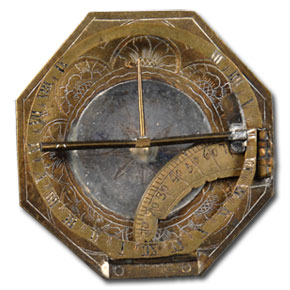
Sung Dynasty (Song Dynasty, 960–1279) The Mongol invasions of 1279 had overthrown the Chinese Sung Dynasty, bringing the rule of the Mongol Yuan. In 1276 AD, when the Mongols invaded and took over China, they had already been ruling a large empire for about fifty years. Their empire stretched from India and Russia to northern China and Korea. In 1276 the Mongols captured the Sung capital at Hangzhou, and by 1279 the Mongols controlled all of China. Kublai Khan, the Mongol leader, moved the capital of the Mongol empire from Karakorum in Central Asia to Beijing, China. At the age of 56, Kublai Khan declared himself emperor of China. As a result of the Mongol control of Asia from the coast of China to the Black Sea, a period of security and stability was provided along the Silk Routes in the middle of the 13th century, known as Pax Mongolica.
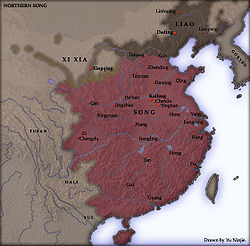 |
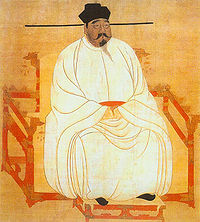 |
|
Northern Sung in 1111 |
Emperor Taizu of the Sung Dynasty |
The Sung Dynasty was a ruling dynasty in China between 960 and 1279. It succeeded the Five Dynasties and Ten Kingdoms Period, and was followed by the Yuan Dynasty. It was the first government in world history to issue banknotes or paper money, and the first Chinese government to establish a permanent standing Chinese navy. This dynasty also saw the first known use of gunpowder, as well as the first use of a compass to discern magnetic declination of true north. More...
Sutras comprise the first of the "three baskets" (tripitaka) of the Buddhist scriptures. In the Shravakayana they generally recount the words of the Buddha, while in the Mahayana the main speaker is often a bodhisattva (in the Shravakayana, "bodhisattva" is the name for a person on the path to enlightenment; often used for the previous lives of the Buddha. In the Mahayana, "bodhisattva" is a being who through compassion for others remains in samsara although fully enlightened). Some internationally well-known sutras were found in the library cave at Dunhuang along the Silk Road. More...
Syr-Darya River One of the two rivers running into the Aral Sea. The area was a focus of irrigated agriculture and sedentary life, with many important cities surrounding the region.
Silk Routes.net | Ipek Yollari.net